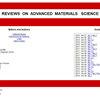热改性对非洲红木、山茱萸、红木和木香木材颜色和化学变化的影响
IF 3.6
4区 材料科学
Q2 MATERIALS SCIENCE, MULTIDISCIPLINARY
引用次数: 2
摘要
摘要热改性是一种环保技术,可以改善木材的各种性能,特别是尺寸稳定性、耐腐性和颜色均匀性。在这项工作中,四种热带木材(非洲红木、梅尔巴乌木、红木和伊罗科木)通过ThermoWood工艺进行了热改性。采用分光光度法、傅里叶变换红外光谱法和湿化学法研究了热处理对木材颜色和化学变化的影响。随着温度的升高,观察到亮度(L*)降低,同时色度值(a*, b*)降低,表明木材表面变暗和褐变。热处理后的半纤维素相对含量下降幅度最大的是桃木和红木,而热稳定性较高的是红木和非洲红木。所有被测树种的亮度差值(ΔL*)与半纤维素含量之间存在较强的相关性(r = 0.88-0.96)。FTIR光谱分析表明,半纤维素和木质素中C = O和C = C键的断裂在木材颜色变化的显色结构的形成中起重要作用。本文章由计算机程序翻译,如有差异,请以英文原文为准。
Impact of thermal modification on color and chemical changes of African padauk, merbau, mahogany, and iroko wood species
Abstract Thermal modification is an environment-friendly technology for improving various wood properties, especially the dimensional stability, decay resistance, and color homogeneity. In this work, four tropical wood species (African padauk, merbau, mahogany, and iroko) were thermally modified by the ThermoWood process. The influence of heat treatment on the color and chemical changes of wood was studied by spectrophotometry, Fourier transform infrared (FTIR) spectroscopy, and wet chemistry methods. As the temperature increased, a decrease in lightness (L*) and a simultaneous decrease in chromatic values (a*, b*) were observed, indicating darkening and browning of the wood surface. As a result of the heat treatment, the relative content of hemicelluloses decreased the most in merbau and mahogany, while the thermal stability of iroko and African padauk was higher. All examined wood species showed a strong correlation between the lightness difference value (ΔL*) and the content of hemicelluloses (r = 0.88–0.96). The FTIR spectroscopy showed that the breakdown of C═O and C═C bonds in hemicelluloses and lignin plays an important role in the formation of chromophoric structures responsible for the color changes in the wood.
求助全文
通过发布文献求助,成功后即可免费获取论文全文。
去求助
来源期刊

Reviews on Advanced Materials Science
工程技术-材料科学:综合
CiteScore
5.10
自引率
11.10%
发文量
43
审稿时长
3.5 months
期刊介绍:
Reviews on Advanced Materials Science is a fully peer-reviewed, open access, electronic journal that publishes significant, original and relevant works in the area of theoretical and experimental studies of advanced materials. The journal provides the readers with free, instant, and permanent access to all content worldwide; and the authors with extensive promotion of published articles, long-time preservation, language-correction services, no space constraints and immediate publication.
Reviews on Advanced Materials Science is listed inter alia by Clarivate Analytics (formerly Thomson Reuters) - Current Contents/Physical, Chemical, and Earth Sciences (CC/PC&ES), JCR and SCIE. Our standard policy requires each paper to be reviewed by at least two Referees and the peer-review process is single-blind.
 求助内容:
求助内容: 应助结果提醒方式:
应助结果提醒方式:


